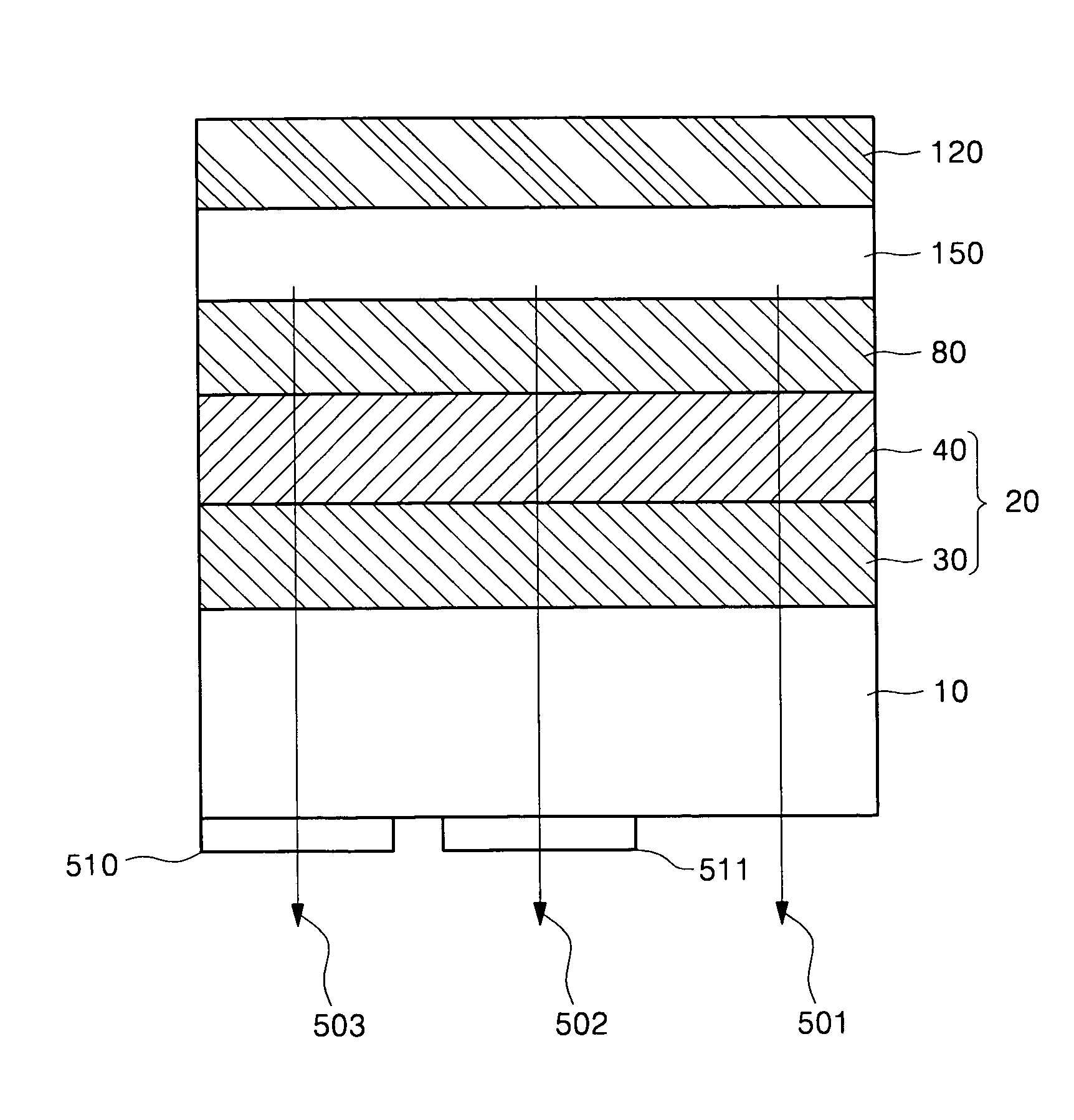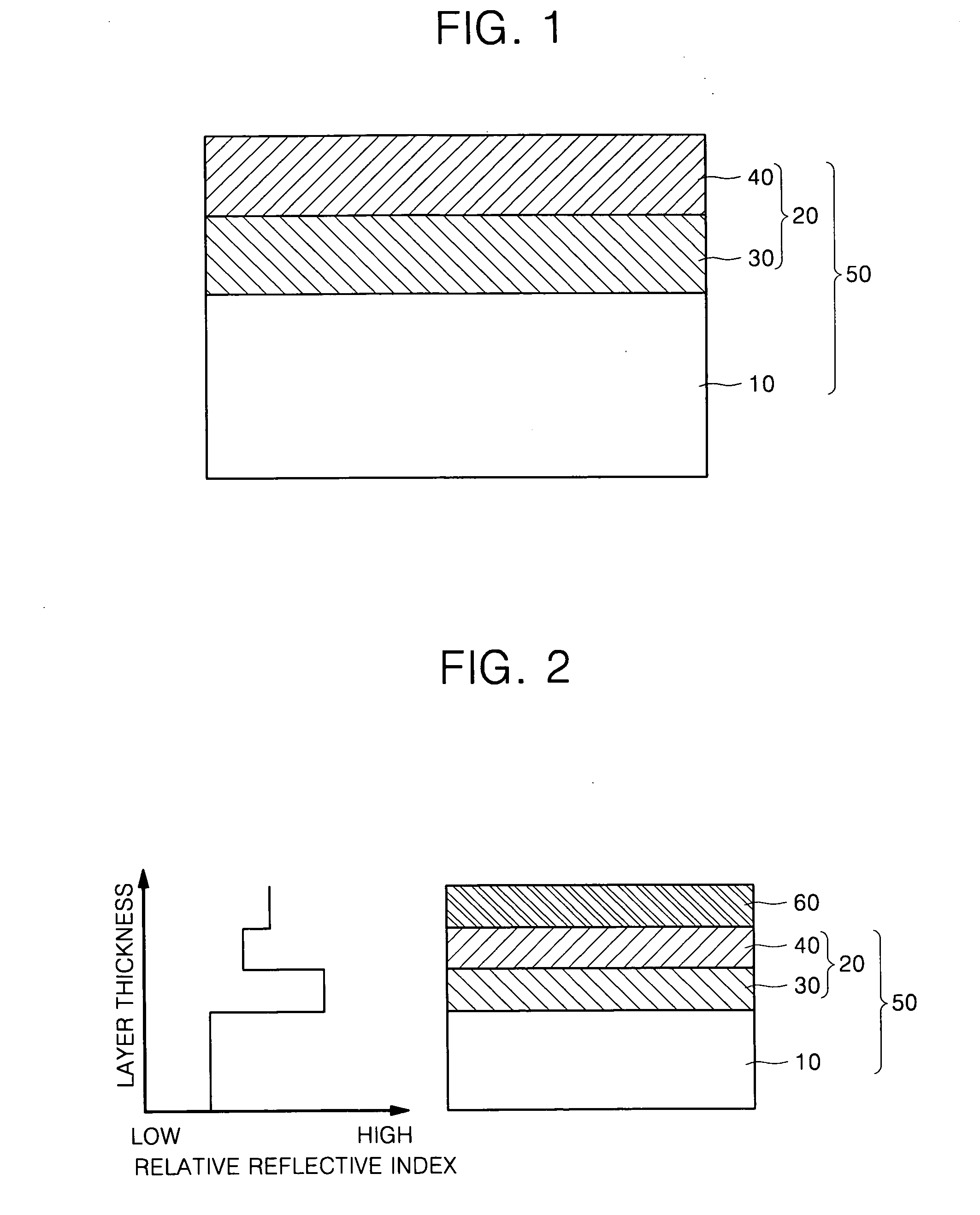Substrate of emitting device and emitting device using the same
a technology of emitting device and substrate, which is applied in the direction of solid-state devices, electric lighting sources, electric light sources, etc., can solve the problems of low affecting the efficiency of light emitting, and the upper limit of light-emitting probability, etc., to achieve good light-emitting efficiency
- Summary
- Abstract
- Description
- Claims
- Application Information
AI Technical Summary
Benefits of technology
Problems solved by technology
Method used
Image
Examples
first embodiment
[0064]FIG. 1 is an exemplary cross-sectional view of a substrate for a light-emitting device according to the present embodiment. Specifically, a substrate 50 for the light-emitting device of the present invention is provided with an optical control layer 20 on one surface of a light transparent substrate 10. The optical control layer 20 is composed of a first layer 30 which has a refractive index higher than that of the light transparent substrate 10, and a second layer 40 which has a refractive index lower than that of the first layer 30, and has a structure where these two layers are layered from the light transparent substrate 10 in that order.
[0065] This substrate for the light-emitting device is used as a substrate of a light-emitting device by mounting an emitting region on an upper portion of the optical control layer 20. The optical control layer 20 converts a wave front of a spherical wave form of emission introduced from the upper portion thereof into that of a plane wav...
second embodiment
[0090]FIG. 4 shows one example of an exemplary cross-sectional view of an inorganic EL device using a substrate for a light-emitting device in accordance to the present embodiment. The light transparent substrate 10 has one surface provided with the optical control layer 20 on which the electrode layer 60, an insulating layer 90, an inorganic emitting layer 100, the insulating layer 90 and the electrode layer 60 are sequentially provided in that order.
[0091] The optical control layer 20 is composed of the first layer 30 having the refractive index higher than that of the light transparent substrate 10 and the second layer 40 having the refractive index higher than that of the first layer 30, both of which are sequentially provided from the light transparent substrate 10. The first layer 30 is disposed on the light transparent substrate 10. And, either a configuration of the inorganic EL device or its material may be arbitrarily selected from the well-known ones.
[0092] According to...
third embodiment
[0093] This embodiment shows an example where the substrate for the light-emitting device described in the first embodiment is applied to an organic EL device. FIG. 5 is an example of a schematic cross-sectional view showing a structure of an organic EL device in accordance with this embodiment. In this embodiment, the substrate for the light-emitting device is sequentially provided with a positive electrode (anode) 80, an emitting layer 130 and a negative electrode (cathode) 120.
[0094]FIG. 6 is an example of an exemplary cross-sectional view showing another structure of an organic EL device related to this embodiment. In this embodiment, the substrate for the light-emitting device is sequentially provided with the positive electrode 80, a hole transporting layer 140, the emitting layer 130 and the negative electrode 120. In addition, other structures may be enumerated, for example a structure composed of positive electrode / hole transporting layer / emitting layer / electron transporti...
PUM
 Login to View More
Login to View More Abstract
Description
Claims
Application Information
 Login to View More
Login to View More - R&D
- Intellectual Property
- Life Sciences
- Materials
- Tech Scout
- Unparalleled Data Quality
- Higher Quality Content
- 60% Fewer Hallucinations
Browse by: Latest US Patents, China's latest patents, Technical Efficacy Thesaurus, Application Domain, Technology Topic, Popular Technical Reports.
© 2025 PatSnap. All rights reserved.Legal|Privacy policy|Modern Slavery Act Transparency Statement|Sitemap|About US| Contact US: help@patsnap.com



